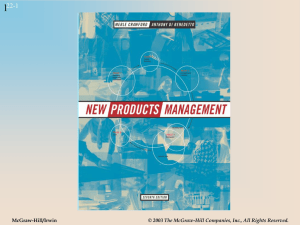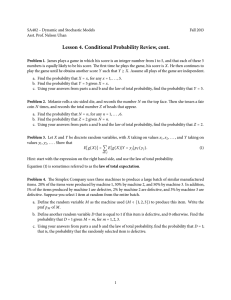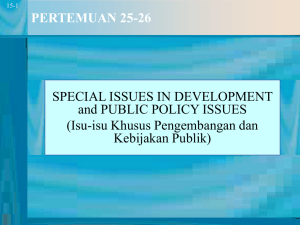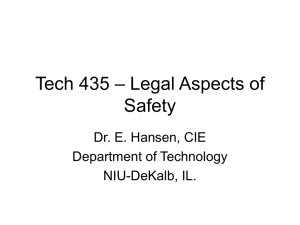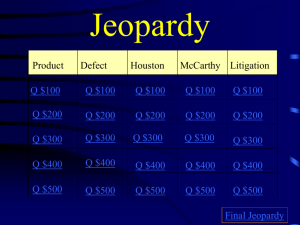Manufacturers` liability for the damages caused by defective products
advertisement
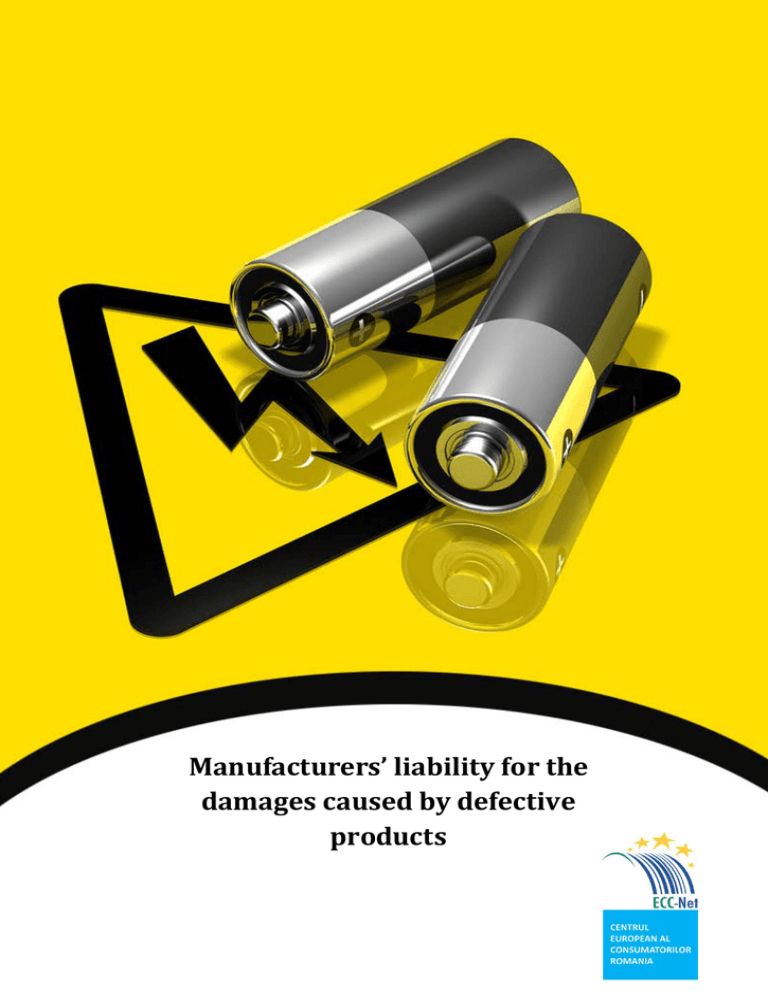
Manufacturers’ liability for the damages caused by defective products Did you buy a TV that caused short-circuiting the electrical installation in your home? Did you suffer burns because of the fire? In such situations you can request compensation of the damage caused, thanks to the mechanism of liability for damage caused by defective products, regulated at Community level by Directive nr. 1999/34/CE, amended by Directive 1999/34/CE and at national lever by Law Nr. 240/2004 regarding the producers’ liability for the damages caused by defective products. These laws provide you protection against the risk of purchasing a product that can endanger your life, health or legitimate interests, without excluding, therefore, compensation for the damage that you suffered. What is a defective product? A defective product is a product which does not provide the safety that you legitimately expect. You must take into account all circumstances, in particular the presentation of the product, all foreseeable uses of the product and the time when the product was put into circulation. A defective product should not be confused with a dangerous one. There are products that are dangerous by their nature, without being defective. You should be fully informed both orally and through the usage instructions so that the product can become safe. For example, a drug administrated in an improper dosage can be dangerous for your health, but can also be good if you follow the instructions for its use. Thus, the defective product does not provide the safety you are entitled to expect. Warning! A product cannot be considered defective just because another product, with improved safety measures, was created later. Who is required to respond if a defective or unsafe product is sold on the market? Who is responsible: the retailer, the wholesale seller, the importer or the manufacturer? As a main rule, the liability for the damages caused by a defective product falls upon the manufacturer, which can be: • The manufacturer of the finished product, of a row material or of a part of the product; • Any person presenting himself as a producer, in that they register on the product their name, trade mark or other distinctive mark; • Any person who imports a product in Romania / from the European Union for sale, lease, purchase or other forms of alienation in their merchandising activity; • Each supplier of that product, if the manufacturer of the product cannot be identified and if the supplier does not provide the injured consumer, in a reasonable time, with the identification data of the manufacturer or of the person who supplied the product; this provision is valid for an imported product too, if the product does not indicate the identity of the importer, even if the name of the manufacturer is mentioned. What does damage mean? • Damage or destruction of any property, other than the defective product, provided that the good is normally for private use or consumption and has been used for your personal use or consumption, and its value is greater than 200 Lei for the products purchased from Romania an 500 Euro for the products purchased in the Community; • Damage caused by death, body or health harm. Under what circumstances you can bind manufacturers’ liability? Product liability is a broad concept, both in terms of people between operating and the nature and type of liability. In terms of people we have seen that products liability can appear between the following people: manufacturers and the other players in the production-distribution-consumption cycle, who acquire products for professional use, for example for resale, redistribution, and between producers on one hand and consumers, on the other hand. As for the nature of the products liability, it can be indictable or civil. The type of liability- contractual liability or tort - may differ according to whether there is or not a contractual link between you and the manufacturer and the nature of the injury. When the defective product itself is the injury, meaning it does not meet the needs for which it was purchased, for example the freezer that you have bought does not freeze, legal liability must come to action, based on the required guarantee against hidden or visible defects of the product. Warning! Defective nature of the product should not be confused with the defect that makes the product unfit for the consumption for which it was acquired. Such dispute is settled under a contractual liability- the guarantee obligation. If the defective product causes injury to other products, except itself, or to you, putting into danger your life, health or body integrity, is the manufacturer's tort liability , even if the product was purchased through a contract. Manufacturers’ liability is available whether or not between him and you is a relationship based on a contract, and you can use it both for existing damage and for the future. This does not mean that, if the damage caused by the defective product does not fall within the scope of Law nr.240/2004, you cannot claim compensations on the basis of contractual or extra contractual liability, or on the basis of any other special liability system existing at that time. In order to bind producers’ civil liability, as it is governed by the regulations from above, you must prove the damage, the defect and the casual relationship between the defect and damage. These three conditions must be fulfilled in order to bind the manufactures’ liability. It is not necessary for the manufacturer to be negligent or be faulty for something. Meanwhile, if you or another person has contributed to cause damage, producers’ liability could be diminished. Moreover, if several persons are responsible for the damage they are jointly responsible. Between the defective product and the damage must be a causal link that you must prove in case of a trail. The causal link between the defective product and the damage caused means that if the product wasn’t defective, the damage wouldn’t happen. Can the manufacturer be absolved of his liability? The manufacturer is not guilty if he can prove that: -he is not the one who put the product on the market; it is understood that putting the product on the market means the action by which the product is available in the market for the first time for distribution or use; if the manufacturer instructs the product to a person to try it, for example a car, does not mean that he put into circulation; also if the product was stolen and the thief used it himself or marketed, does not mean that he put into circulation. - the defect which caused the damage did not exist at the time when the product was put into circulation by him or that this defect came into being afterwards; for example, the manufacturer can prove that the same number of samples belonging to the defective product was verified by the competent bodies and proved not to be defective. - that the product was neither manufactured by him for sale or any form of distribution for economic purpose nor manufactured or distributed by him in the course of his business; - defective product is required due to conditions imposed by regulations issued by competent authorities; if the public authorities have taken imprudent measures, and by respecting them, the manufacturers have put defective products on market, the public authorities will be held liable for damage caused. - the scientific and technical knowledge at the time of the release of product did not allow the existence of a defect detection; if, for example, a food product put into circulation is found to be carcinogenic after some time, but at the time of release, scientific and technical knowledge have not discovered this, the manufacturer cannot be held liable. - the defect is due to failure by the consumer of user instructions provided in the technical documentation accompanying the product, proven technical expertise in specialized. The manufacturer of components of a product will not be liable for damage caused to the consumer if he proves that the finished product manufacturer defect is due to bad design because the assembly has been mounted or instructions given by him. Warning! The manufacturer of the product put on market will not respond unless you prove one of the above statements. How to take action against the manufacturer? To assert your rights, you must enter an legal action within three years from the moment you became aware of the damage, the defect and the producer. Appeal must be lodged before the end of 10 years from the release of the product. Action to repair damage is for the court in whose jurisdiction the damage occurred. For cross-border disputes can study the material on "Jurisdiction in cross-border contracts concluded by consumers ", located on the ECC Romania site – www.eccromania.ro European Consumer Centre Romania Str. Maior Aviator Ștefan Sănătescu nr. 44 Et. 1, Ap. 2, Sector 1, Bucharest, 011478 Tel/fax: +40.21.315.71.49 E-mail: office@eccromania.ro Web: www.eccromania.ro www.facebook.com/ECC.Romania https://twitter.com/eccromania/ Co-funded by the European Union This infosheet is part of the action 670709 - ECC-Net RO FPA which has received funding under a grant for an ECC action from the European Union’s Consumer Programme (2014-2020). The content of this material represents the views of ECC Romania only and it is its sole responsibility; it cannot be considered to reflect the views of the European Commission and/or the Consumers, Health, Agriculture and Food Executive Agency or any other body of the European Union. The European Commission an the Agency do not accept any responsibility for use that may be made of the information it contains.
